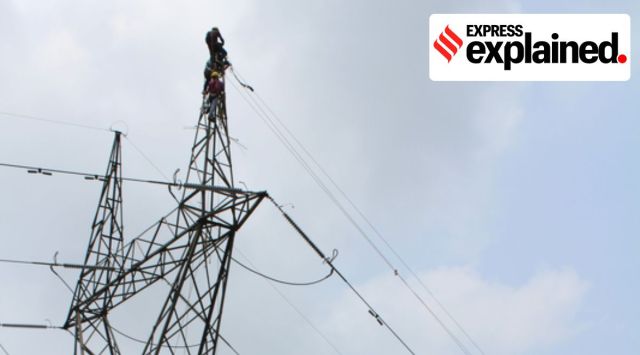What is KFON, Kerala’s scheme for internet connectivity for all households
Through KFON, Kerala, the first state to declare the right to internet as a basic right, aims to reduce the digital divide by ensuring high speed broadband internet access to all houses and government offices.
 Work in progress for KFON, an optical fibre cable network of 30,000 kms, with 375 Points-of-Presence, across Kerala. (Image via kfon.kerala.gov.in)
Work in progress for KFON, an optical fibre cable network of 30,000 kms, with 375 Points-of-Presence, across Kerala. (Image via kfon.kerala.gov.in) The Kerala government Monday (June 5) officially launched the Kerala Fibre Optical Network (KFON), one of its flagship projects envisaged during the first term of Chief Minister Pinarayi Vijayan.
Through KFON, Kerala, which was the first state to declare the right to internet as a basic right, aims to reduce the digital divide by ensuring high speed broadband internet access to all houses and government offices. It is also intended to give a fillip to e-governance and accelerate Kerala’s journey towards being a knowledge-based economy.
What is KFON?
Basically, KFON will act as an infrastructure provider. It is an optical fibre cable network of 30,000 kms, with 375 Points-of-Presence across Kerala. The KFON infrastructure will be shared with all service providers, including cable operators. While KFON will do the cable work for government offices, individual beneficiaries will have to depend on private, local internet service providers.
In many districts, Kerala Vision Broadband, an initiative of cable TV operators, is providing the internet service. The KFON infrastructure will also benefit private service providers as they can use its cable network. Internet connectivity to the households would be provided by local ISP/TSP/cable TV providers.
What is its spread?
In the first stage of KFON, the government wants to provide connectivity to 30,000 government offices and 14,000 BPL families in the state. As on June 5, connectivity has been provided to 17,412 government offices and 2,105 houses, and cable network has been laid down to give connection to 9,000 houses.
KFON promises an internet speed from 10 mbps to 10 Gbps. The quality of mobile phone calls is also expected to improve. Once KFON is connected to mobile towers in Kerala, it will speed up transition to 4G and 5G.
What was the need for it?
The CPI(M) government in Kerala is showcasing KFON as part of the Left’s alternative model of development. In the telecom sector dominated by private players, KFON is being displayed as the CPI(M)’s commitment to the public sector. The government is of the view that existing TELCOS have only limited infrastructure in the rural areas and their wireless connectivity infrastructure is providing only limited bandwidth. Due to the low business potential in rural areas, private TELCOs are not keen to enhance connectivity infrastructure.
Besides, the Kerala State Wide Area Network (KSWAN), the existing state Information Infrastructure connecting government offices, is limited to 3,800 premises. Hence, the Government in 2017 decided to establish KFON, for efficient service delivery, assured Quality of Service, reliability, interoperability, and security.
Who are the stakeholders?
The Rs 1,611-crore KFON project is a joint venture of Kerala State Electricity Board (KSEB) and Kerala State IIT Infrastructure Limited. The project was announced in 2017, but work started in 2019 with a plan to become functional in 2021. The project implementation was taken up by a consortium led by Central PSU Bharat Electronics Limited. PriceWaterhouseCoopers is the consultant of the project.
While Kerala State Information Technology Infrastructure Ltd (KSITIL) would be responsible for the operations and maintenance of the project, the infrastructure asset shall be owned by KSEBL. Bharat Electronics (BEL) is the system integrator for the KFON project. BEL has taken the tasks of rolling the optical fibre cable network, setting up network point of presence locations and providing connectivity to government institutions.
BEL would be in charge of operation and maintenance of the project for seven years. The project is fully funded by Kerala Infrastructure Investment Fund Board (KIIFB), the state government agency for funding infrastructure projects.
What services will it provide?
The aim of the KFON is to create a core network infrastructure (information highway) with non-discriminatory access to all service providers, and to ensure a reliable, secure and scalable intranet connecting all government offices and educational institutions. Its major services are connectivity to government offices, leasing of dark fibre, internet leased line, fibre to the home, wifi hotspots, colocation of assets under network operating centres and Point-of-Presences, internet protocol television, OTT, and cloud hosting.
The Union Department of Telecommunications had provided Infrastructure Provider (category one) licence as well as the Internet Service Provider licence (category B) to the KFON. The IP licence allowed the KFON to obtain fibre optic lines (dark fibre), towers, duct space, network and other related infrastructure facilities for establishing an optic fibre network.
How will it help the poor?
A major highlight of the KFON is that the government wants to ensure internet connection for 20 lakh families below poverty line. In the first phase, as many as 14,000 BPL families would get connections to high-speed internet, free of cost. With time, 100 BPL families in each of the state’s 140 Assembly constituencies will be selected for this scheme
- 01
- 02
- 03
- 04
- 05






































